Mixing your own caffeine-free herbal tea blends lets you create flavors and health benefits that match your preferences perfectly. You have the freedom to experiment and combine herbs like chamomile for relaxation or peppermint for digestion, tailoring your drink to your wellness goals. By adjusting ratios, you control the strength and potency of each blend, making the process both fun and creative. Plus, discovering unique flavor profiles can be a delightful journey. If you're curious about essential tips, techniques, and ingredients for creating your perfect tea blend, there's much more to explore.
Benefits of Herbal Tea Blending
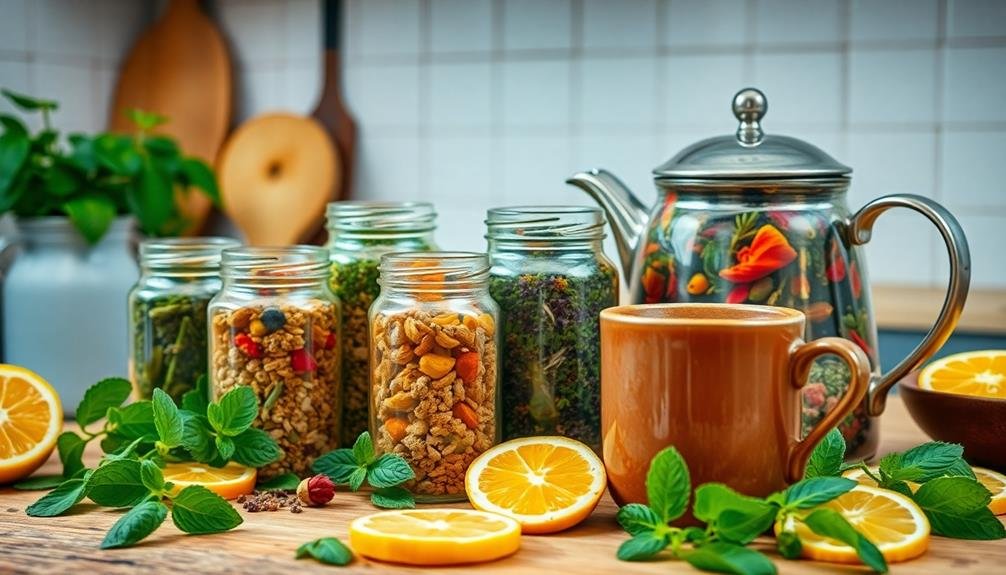
Herbal tea blending offers a delightful way to enhance both flavor and health benefits. When you create your own blends, you can tailor each cup to your taste preferences and wellness goals.
Experimenting with various herbs allows you to discover unique flavor profiles that excite your palate and make your tea-drinking experience more enjoyable.
One significant benefit of blending is the potential for increased health advantages. Different herbs contain various properties that can support your well-being. For example, combining chamomile with peppermint can promote relaxation while aiding digestion.
You can also mix herbs like ginger and turmeric to boost your immune system and reduce inflammation.
Additionally, blending allows you to control the strength and potency of your tea. You can adjust the ratios of each ingredient to find the perfect balance that suits your needs.
Plus, blending can be a fun and creative process, giving you the freedom to experiment and discover what works best for you.
Choosing Your Base Ingredients
When choosing your base ingredients for herbal tea blends, consider popular herbal bases like chamomile, rooibos, or peppermint.
These bases not only offer unique flavors but also set the stage for creative pairings with other herbs and spices.
Experimenting with combinations can lead to delightful discoveries that cater to your taste preferences.
Popular Herbal Bases
Choosing the right base for your caffeine-free herbal tea blends sets the foundation for flavor and health benefits. When you select a strong and aromatic herbal base, it allows your blend to shine while delivering unique properties. Here are some popular herbal bases to take into account:
| Herbal Base | Benefits |
|---|---|
| Chamomile | Promotes relaxation and sleep |
| Peppermint | Aids digestion and revitalizes breath |
| Rooibos | Rich in antioxidants and caffeine-free |
| Hibiscus | Supports heart health and adds tartness |
| Lemongrass | Boosts immunity and adds citrus notes |
Each of these bases brings its own distinct flavor and wellness benefits to your tea. Chamomile's calming qualities make it perfect for winding down, while peppermint offers a invigorating kick. Rooibos is naturally sweet and pairs well with various flavors.
Flavor Pairing Ideas
To create a delightful caffeine-free herbal tea blend, it's essential to contemplate how different flavors interact with your chosen base. Start by selecting a primary herb; chamomile is soothing while hibiscus offers a tangy twist.
Once you have your base, think about complementary flavors. Mint can refresh a chamomile blend, while orange peel can add zest to hibiscus.
Next, consider the balance of sweetness and earthiness. If you're using rooibos, a naturally sweet base, pairing it with vanilla or almond can enhance its richness. On the other hand, earthy ingredients like lemongrass can brighten up a heavier blend.
Don't forget about spices! A pinch of cinnamon or ginger can introduce warmth and depth, especially during colder months. For a floral note, try adding lavender or rose petals, which can elevate a simple blend into something special.
Experiment with ratios to find your perfect combinations. Start with small amounts, and adjust based on your taste preferences.
You'll discover that the right pairings not only enhance the flavor but also create a unique tea experience tailored just for you. Happy blending!
Understanding Flavor Profiles
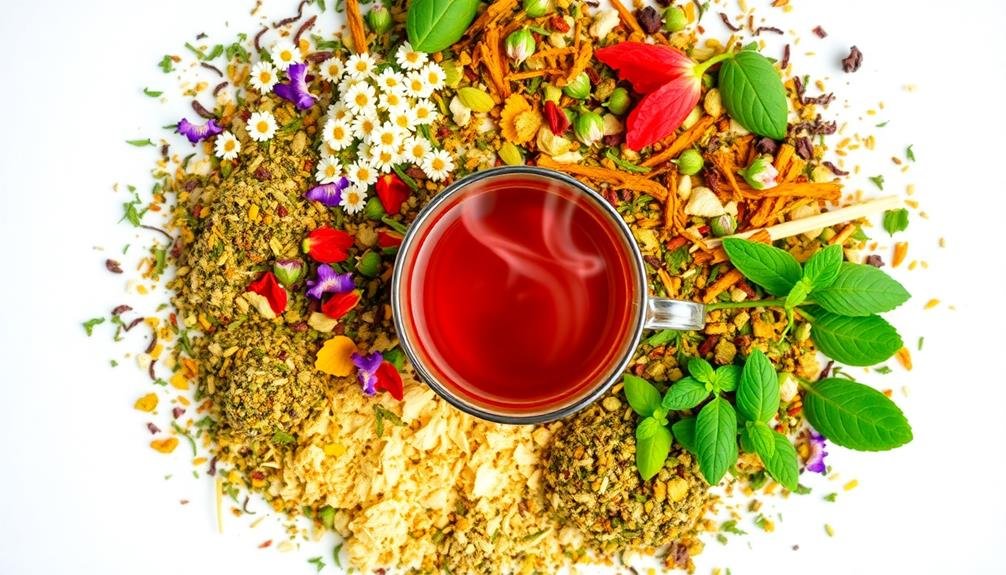
When crafting your caffeine-free herbal tea blends, understanding flavor profiles is essential.
You'll want to select herbal ingredients that not only complement each other but also create a balanced taste and aroma.
This balance can elevate your tea experience, making each sip enjoyable and unique.
Herbal Ingredients Selection
Crafting the perfect caffeine-free herbal tea blend starts with understanding the diverse flavor profiles of various herbal ingredients. Each herb offers its own unique taste, whether it's the invigorating zest of peppermint, the warm, earthy notes of chamomile, or the floral sweetness of hibiscus. By familiarizing yourself with these flavors, you can create a blend that excites your palate.
Consider the balance of flavors you want to achieve. If you prefer a bright and energizing tea, you might include zesty lemon balm or sharp ginger. For a more soothing experience, opt for calming herbs like lavender or lemon verbena.
It's also important to think about the texture and mouthfeel of your tea; some herbs, like licorice root, can add a smooth sweetness that enhances your blend.
Don't forget to explore combinations that complement each other. For example, pairing the minty freshness of spearmint with the fruity undertones of apple or berry can create an enticing mix.
Experimenting with different herbal ingredients will lead you to discover new and delightful flavor profiles, ensuring your caffeine-free herbal tea blends are both enjoyable and satisfying.
Balancing Taste and Aroma
Balancing taste and aroma in your herbal tea blends is vital for creating an enjoyable experience that engages all your senses. When you mix your own blends, you have the power to experiment with different flavor profiles. Start by considering the primary flavors you want to highlight. For example, if you enjoy a sweet taste, you might choose chamomile or licorice root. If you prefer something more robust, try adding peppermint or ginger.
Next, think about the aromas. Fragrant herbs like lavender or lemongrass can elevate your blend, offering a delightful sensory experience. It's important to strike a balance; if you've got strong flavors, pair them with milder aromatic herbs to guarantee they don't overpower each other.
Additionally, pay attention to the herbal ratios. A good rule of thumb is to use a base herb that provides depth, complemented by supporting flavors and aromas.
Essential Blending Ratios
Finding the right blending ratios is essential for creating a harmonious herbal tea.
You'll want to balance flavors, aromas, and health benefits to achieve that perfect cup. Here's a simple guide to help you get started:
- Base Herbs (50-70%): These are the primary ingredients that set the foundation of your blend. Choose from chamomile, rooibos, or peppermint. Aim for this ratio to guarantee your tea has a strong, pleasant body.
- Flavoring Herbs (20-30%): These ingredients add depth and complexity to your blend. Think of hibiscus for tartness, lemon balm for freshness, or cinnamon for warmth. Adjust the proportion based on how bold you want the flavors to be.
- Supportive Herbs (5-10%): These are secondary herbs that offer additional health benefits or subtle flavors. Consider using ginger for a spicy kick, or valerian root for relaxation. Since they can be potent, keep their ratio lower.
Experiment with these ratios to find what resonates with your palate.
Techniques for Effective Mixing
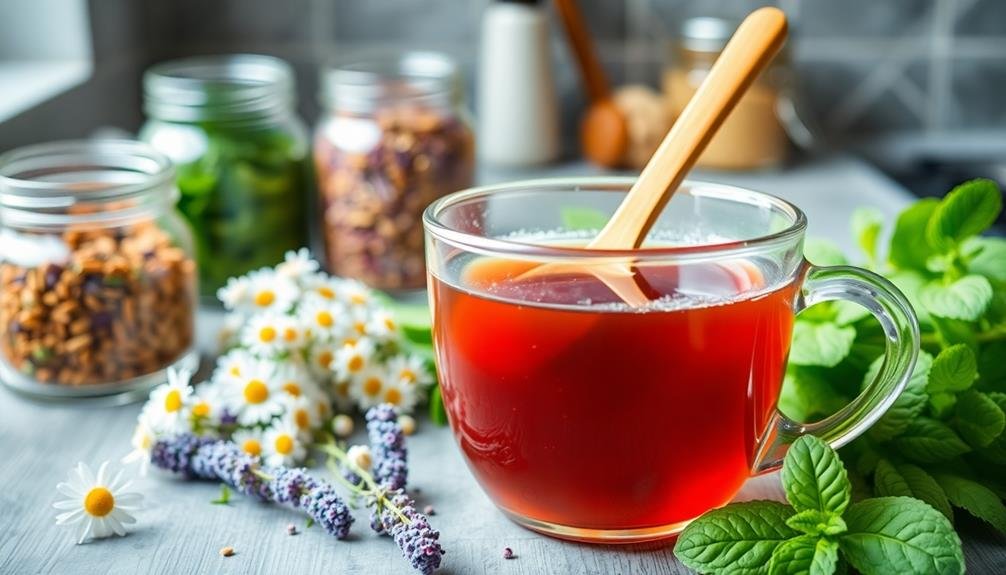
Once you've determined your blending ratios, the next step is to guarantee your herbs mix well together for a flavorful and cohesive tea.
Start by breaking down your herbs into smaller pieces if they're large. This increases the surface area, allowing the flavors to meld more effectively. Use your hands or a mortar and pestle to gently crush the herbs, but be careful not to turn them into powder.
Next, layer your herbs in a bowl according to your ratios. This way, you can visually assess the balance before mixing.
When you combine them, use a gentle folding motion rather than stirring aggressively; this preserves the integrity of each herb.
Consider mixing in small batches first to test your flavor profile. You can always adjust your ratios based on your preferences without wasting larger quantities.
Tools for DIY Herbal Teas
Creating your own herbal teas at home can be a rewarding experience, and having the right tools makes all the difference. To get started, you don't need much, but a few essentials will elevate your tea-making process.
- Herb Grinder: A good grinder helps you break down dried herbs and spices, releasing essential oils and maximizing flavor. Look for a sturdy model that can handle various textures.
- Tea Infuser or Strainer: An infuser lets you steep your herbal blend without the fuss of loose leaves floating in your cup. Choose one that's easy to clean and allows for adequate water flow to enhance extraction.
- Storage Containers: Keep your dried herbs fresh in airtight containers. Opt for glass or opaque jars to protect them from light, which can degrade flavor over time.
Label each container for easy access.
With these tools in hand, you'll be ready to mix and match your favorite herbal ingredients. Enjoy the creative process and the delightful flavors that come with crafting your caffeine-free herbal teas!
Experimenting With Additives
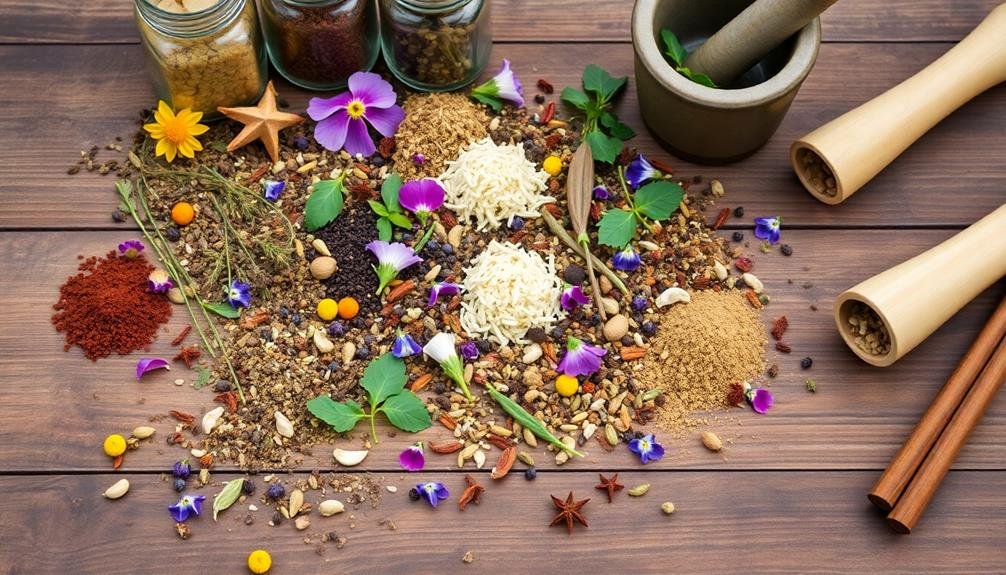
When crafting your herbal teas, don't hesitate to experiment with various additives to enhance flavor and health benefits. You can easily elevate your blends by incorporating ingredients like dried fruits, spices, and floral elements.
For instance, adding dried hibiscus or rose petals can introduce a lovely aroma and vibrant color, while dried apple or peach pieces lend a touch of sweetness.
Spices are another excellent addition. Think about mixing in cinnamon, ginger, or even a dash of cayenne for an unexpected kick. These not only add flavor but can also offer digestive and anti-inflammatory benefits.
Herbal extracts, like vanilla or almond, can also provide depth to your blend without adding caffeine.
Don't forget about the potential of fresh herbs! A sprig of mint or basil can transform your tea into a revitalizing beverage.
Just remember to start small; it's easier to add more than to try to balance out overpowering flavors. Keep notes on your mixtures, so you can replicate your favorites or adjust them for next time.
Enjoy the process, and let your taste buds guide you to your perfect herbal tea blend!
Storing Your Custom Blends
Properly storing your custom herbal tea blends guarantees they maintain their flavor and potency over time.
If you want to enjoy your creations for months to come, follow these simple storage tips:
- Use Airtight Containers: Choose glass jars or metal tins with tight-fitting lids. This helps keep moisture and air out, preserving the freshness of your blends.
- Keep Away from Light and Heat: Store your containers in a cool, dark place, like a pantry or cupboard. Exposure to light and heat can degrade the quality of your herbs, so avoid keeping them near the stove or in direct sunlight.
- Label Your Blends: Don't forget to label your containers with the blend name and date of creation. This guarantees you can easily identify your mixes and track their freshness, helping you enjoy them at their best.
Enjoying Your Herbal Creations
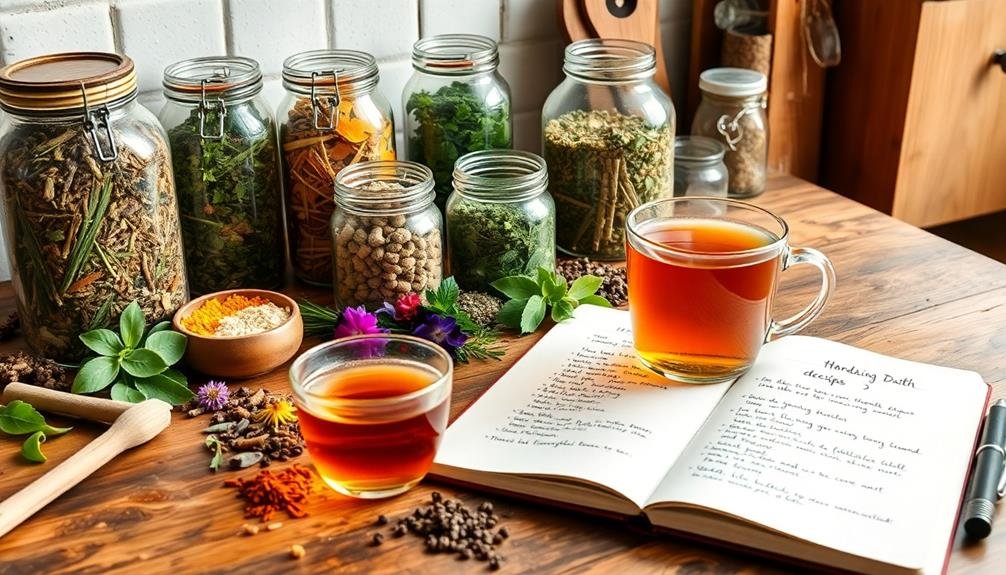
Sipping your custom herbal tea blends can be a delightful experience that transports you to a world of flavor and relaxation. When you brew your concoctions, you engage all your senses, from the vibrant colors of the herbs to the enticing aromas that fill your kitchen. Each cup becomes a personal journey, allowing you to explore the unique profiles of the ingredients you've chosen.
To elevate your tea-drinking ritual, consider the setting. Find a cozy spot, perhaps a favorite chair or a sun-drenched corner of your home. As you settle in, take a moment to enjoy the visual appeal of your brew. The hues can be as enchanting as the taste itself.
Don't hesitate to experiment! Add a splash of honey or a squeeze of lemon to enhance flavors, or pair your tea with a light snack that complements your blend. Invite friends over for a tasting session, sharing your creations and discovering their favorites.
Ultimately, enjoying your herbal creations is about savoring the moments they bring. So, brew a cup, take a deep breath, and let the warmth and flavors wash over you. You've earned this time for yourself.
Frequently Asked Questions
Can I Mix Herbal Teas With Traditional Teas?
Yes, you can mix herbal teas with traditional teas! Combining them creates unique flavors and potential health benefits. Just experiment with different ratios to find the blend that suits your taste preferences best. Enjoy your tea adventures!
How Long Do Homemade Blends Stay Fresh?
Homemade herbal tea blends typically stay fresh for about six months when stored in an airtight container, away from light and moisture. Make sure you check for any off smells or flavors before brewing.
Are There Any Allergies to Consider When Blending?
Yes, you should consider allergies when blending. Common allergens include chamomile, mint, and certain spices. Always check for sensitivities, and if you're unsure, consult a healthcare professional before trying new herbal combinations.
What Is the Best Time to Drink Herbal Tea?
The best time to drink herbal tea is whenever you need a moment to relax. Sipping it in the evening can help unwind, while a mid-afternoon cup can boost your mood and focus. Enjoy it anytime!
Can I Use Dried Fruits in My Blends?
Absolutely, you can use dried fruits in your blends! They'll add natural sweetness and unique flavors. Just remember to balance them with other herbs to create a delicious, well-rounded herbal tea experience. Enjoy experimenting!
In Summary
Mixing your own caffeine-free herbal tea blends lets you create flavors that suit your taste and health needs. By experimenting with different ingredients and ratios, you can discover unique combinations that not only taste amazing but also offer various benefits. Plus, the process is fun and rewarding! So go ahead, gather your favorite herbs, get creative, and enjoy the satisfaction of sipping on your personalized herbal concoctions. Your perfect cup of tea awaits!


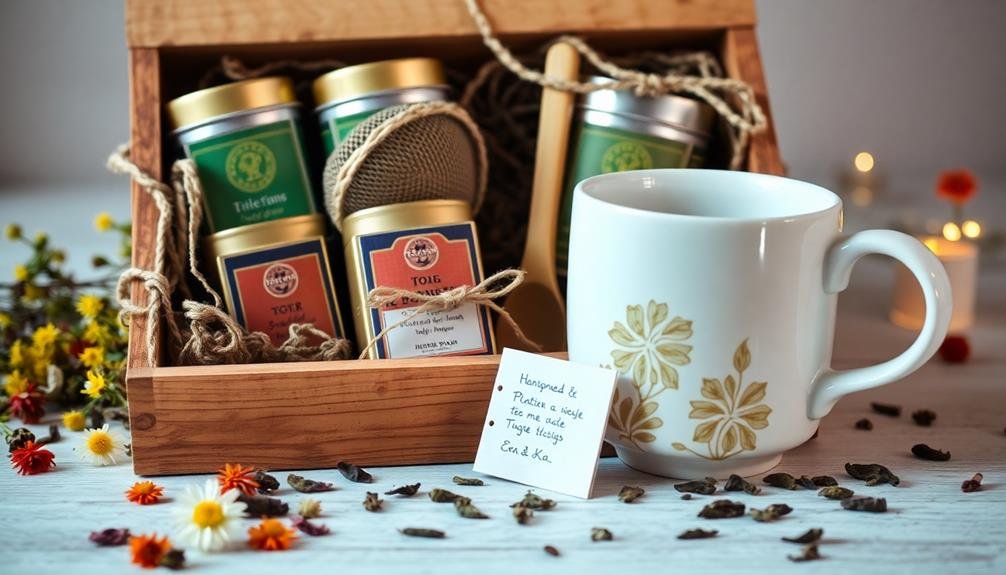
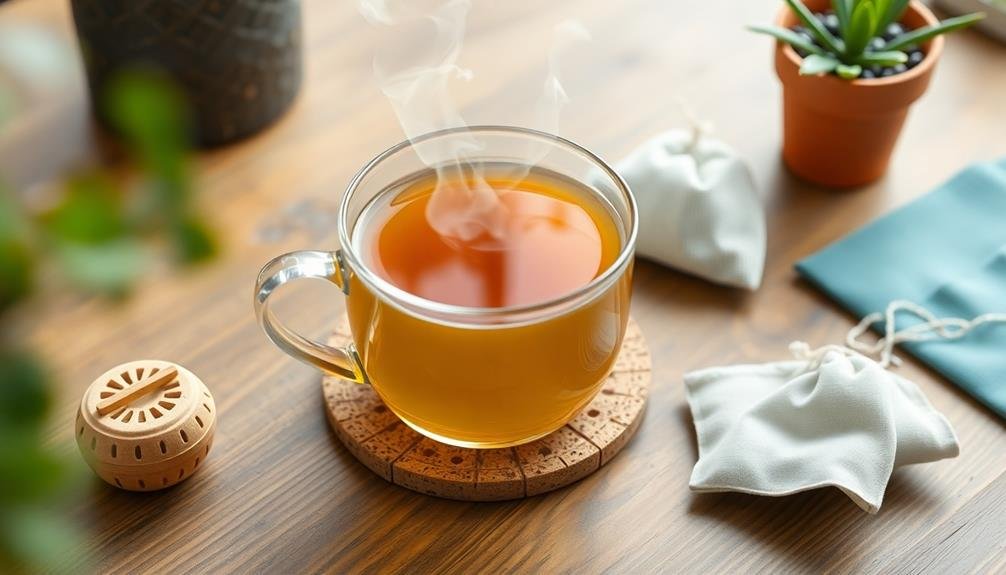
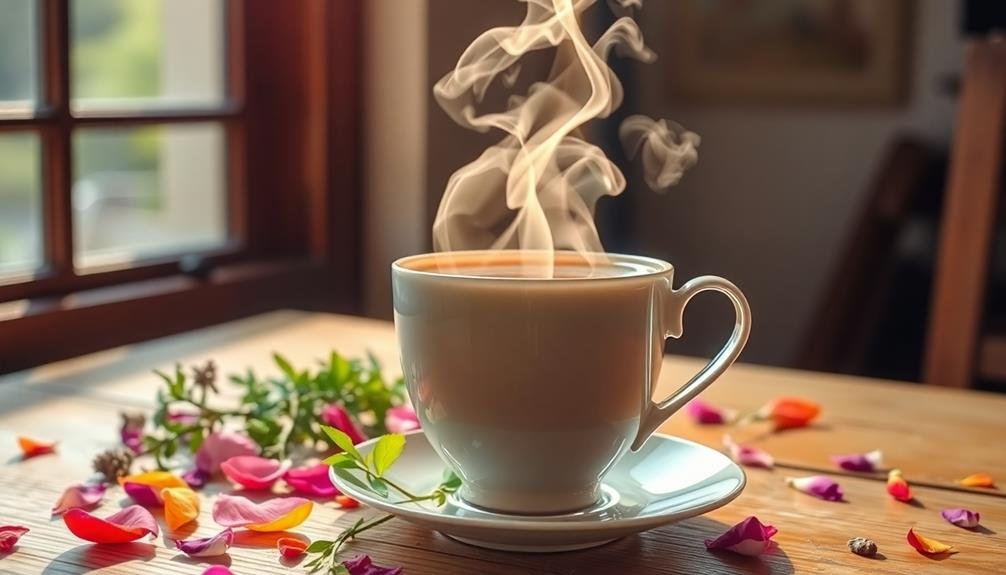
Leave a Reply